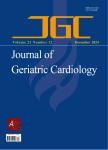Five-year major clinical outcomes between first-generation ana second- generation drug-eluting stents in acute myocardial infarction patients underwent percutaneous coronary intervention
Five-year major clinical outcomes between first-generation ana second- generation drug-eluting stents in acute myocardial infarction patients underwent percutaneous coronary intervention作者机构:Division of Cardiology Department of Internal Medicine Kangwon National University School of Medicine Chuneheon South Korea Cardiovascular Center Korea University Guro Hospital Seoul South Korea Department of Medicine Korea University Graduate School Seoul South Korea Cardiovascular Center Cheong Ju St. Mary hospital Cheong Ju Chung Buk South Korea SCardiology Department Konkuk University Chungju Hospital Chungju South Korea Department of Internal Medicine Cardiovascular Division Dankook University Hospital Cheonan South Korea Department of Cardiology Soonchunhyang University Gumi Hospital G-umi South Korea Cardiology Department Soonchunhyang University Cheonan Hospital Cheonan South Korea
出 版 物:《Journal of Geriatric Cardiology》 (老年心脏病学杂志(英文版))
年 卷 期:2018年第15卷第8期
页 面:523-533页
核心收录:
学科分类:0710[理学-生物学] 070801[理学-固体地球物理学] 07[理学] 08[工学] 0708[理学-地球物理学] 0816[工学-测绘科学与技术] 071002[理学-动物学]
主 题:Acute myocardial infarction Clinical outcomes Drug-eluting stem
摘 要:Background There were limited data comparing the major clinical outcomes between first-generation (1G)-drug eluting stentts (DES) and second-generation (2G)-DES in patients with acute myocardial infarction (AMI) after percutaneous coronary intervention (PCI) during very long follow-up periods. We thought to investigate the comparative efficacy and safety of 2G-DES compared with 1G-DES in AMI patients during 5-year follow-up periods. Method A total of 1016 eligible AMI patients who underwent PCI with 1G-DES [paclitaxel-, sirolimus-, 1G-zotarolimus-eluting stent (endeavor~ or endeavor sprintS), n = 554] or 2G-DES [2G-zotarolimus (endeavor resolute~)- or everolimus-eluting stent, n = 462] were enrolled. The primary endpoint was the occurrence of major adverse cardiac events (MACE) defined as total death, non-fatal myocardial infarction (MI), target lesion revascularization (TLR), target vessel revascularization (TVR), non-target vessel revascularization (Non-TVR) and the secondary endpoint was stem thrombosis (ST) at 5 years. Results Two propensity score-ma- tched (PSM) groups (232 pairs, n = 464, C-statistic = 0.802) were generated. During the 5-year follow-up period, the cumulative incidence of TLR [hazard ratio (HR): 3.133; 95% confidence interval (CI): 1.539-6.376; P = 0.002], TVR (HR: 3.144; 95% CI: 1.59645.192; P = 0.001) and total revascularization rate (FIR: 1.874; 95% CI: 1.086-3.140; P = 0.023) were significantly higher in 1G-DES compared with 2G-DES after PSM. However, the incidence of total death, non-fatal MI and ST were similar between the two groups. Conclusion In this single-center and all-comers registry, 2G-DES's superiorities for TLR, TVP, and total revascularization in AMI patients suggested during 5-year clinical follow-up periods.




